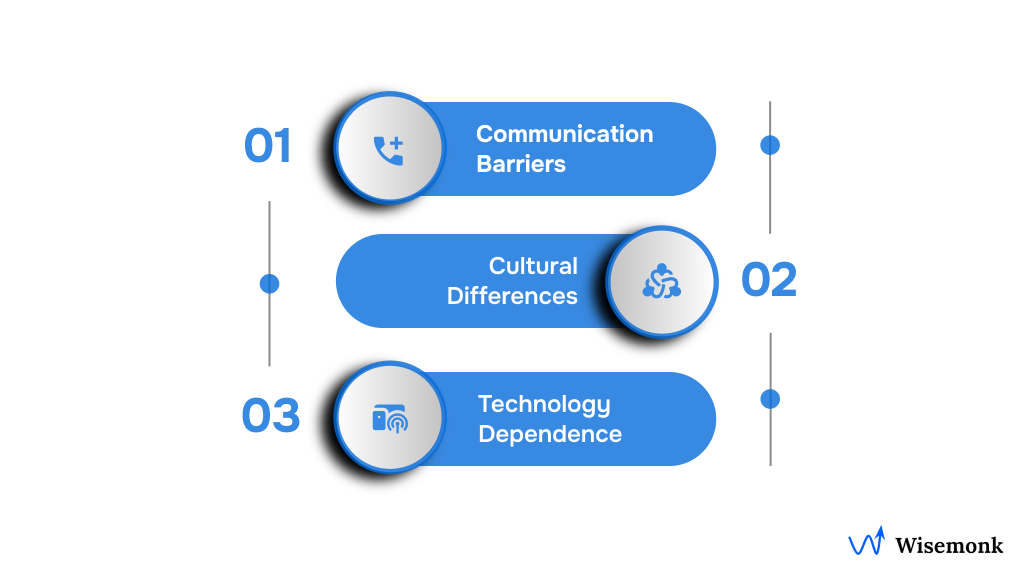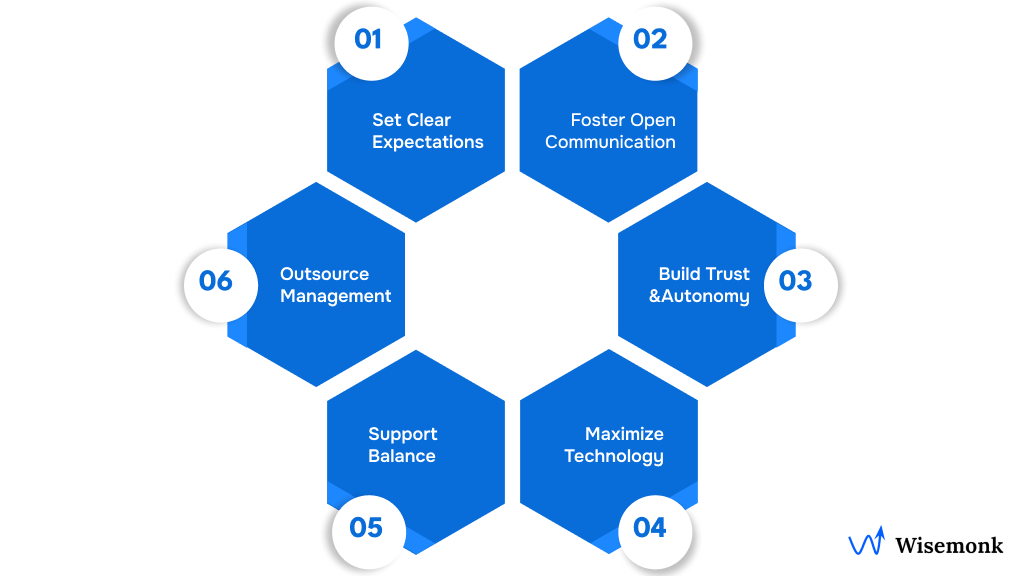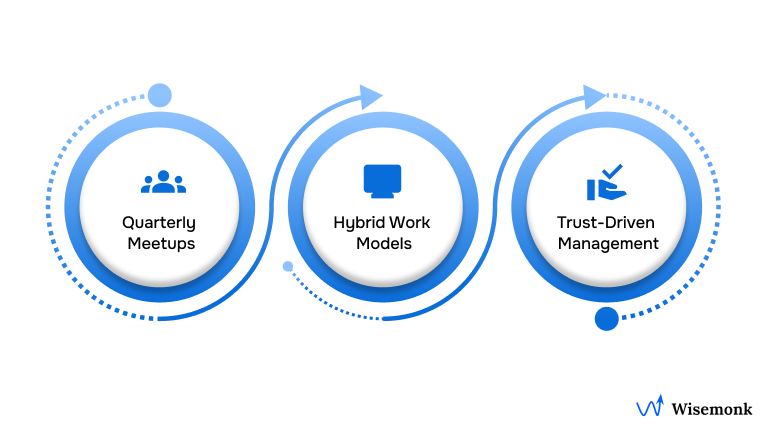- Managing remote teams requires clear communication, trust, and the right tools.
- Set clear expectations, promote autonomy, and prioritize work-life balance.
- Time zone management and employee morale are key challenges to address.
- Trust-based leadership and flexible work models enhance productivity.
Managing a remote team, especially across different time zones and cultures, can feel like an overwhelming challenge for US-based employers. Managing communication gaps, different work ethics, and payroll and compliance challenges can be difficult for HR teams, often distracting them from strategic goals. We understand how frustrating this can be and the pressure it puts on HR teams to maintain smooth operations. However, with the right strategies in place, these challenges can be turned into opportunities for growth and efficiency.
In this blog, we’ll explore proven methods to manage remote teams effectively, helping you overcome common obstacles while boosting productivity and employee satisfaction.
Let’s start by examining the unique challenges that come with managing remote teams.
Understanding the Challenges of Remote Team Management

The lack of face-to-face interaction and the distance between team members often create challenges that can hinder productivity, communication, and overall team cohesion. Let’s look at some of the key hurdles faced by companies when managing remote teams:
1. Communication Barriers
Without in-person interactions, remote teams often struggle with communication issues, from misunderstandings to missed messages. The absence of visual cues like body language can make it difficult to exchange emotions, leading to potential misinterpretations.
2. Cultural Differences
Remote teams often consist of employees from diverse backgrounds, which can result in differences in work styles, communication preferences, and expectations. These differences, if not addressed, can cause friction and slow down team dynamics.
3. Technology Dependence
Over-reliance on digital tools for communication, collaboration, and project management can lead to technical difficulties and system overload. Tools that work perfectly for some team members may cause frustration for others, especially if not everyone is equally comfortable with the technology.
These challenges can feel daunting, but with the right strategies, they are surmountable. Let’s explore effective strategies for overcoming these barriers and managing remote teams with success.
Core Strategies for Managing Remote Teams

Successfully managing remote teams requires strategic, well-executed approaches that prioritize clear communication, trust, and productivity. With teams often spread across multiple time zones and regions, these strategies are essential for creating a cohesive and efficient work environment. Here are key strategies that can help manage remote teams effectively:
1. Set Clear Expectations
A critical first step in managing remote teams is setting clear expectations around roles, responsibilities, and performance metrics. Defining these parameters early helps mitigate confusion and fosters accountability.
Clear expectations help ensure that everyone understands their tasks and deadlines, which is vital for effective remote team management. Establishing communication guidelines and availability norms is also crucial for seamless collaboration, ensuring team members are aligned on working hours and responsiveness.
2. Foster Open Communication
Communication is the backbone of any successful remote team. Establishing appropriate communication channels for different tasks is crucial. Use instant messaging for quick questions, emails for formal updates, and video calls for complex discussions. This approach helps prevent misunderstandings and ensures clarity.
Regular check-ins are also essential for maintaining alignment, ensuring everyone stays on track with their objectives. Open communication helps remote employees feel connected to the team and the organization, fostering collaboration even across vast distances.
3. Build Trust and Autonomy
Trust is a cornerstone of remote team success. Empowering employees to manage their own work and make decisions independently fosters a sense of responsibility.
Focusing on results rather than processes allows employees the flexibility to find the best ways to complete their tasks. Trust encourages team members to take ownership of their roles, leading to increased motivation and productivity.
Avoiding micromanagement helps build a culture of autonomy and accountability, which is essential for remote team engagement.
4. Leverage Technology Effectively
Technology is important for managing remote teams. Using tools like apps for projects, messaging, and file sharing helps teams stay organized and communicate better.
Ensuring all team members are comfortable with these tools is important for smooth operations. Training employees to use collaboration tools effectively helps prevent frustration and allows teams to stay productive. It’s essential to strike the right balance and avoid overwhelming the team with too many digital platforms.
5. Promote Work-Life Balance
Promoting a healthy work-life balance is vital for maintaining employee satisfaction and preventing burnout. Offering flexible working hours and ensuring employees take regular breaks can help maintain productivity without overloading team members.
Supporting mental health and fostering a culture of wellness is crucial for remote teams, especially when isolation can become a significant issue.
Providing access to resources such as counseling, fitness programs, or stress-relief activities demonstrates to employees that the organization values their well-being.
6. Outsource Remote Team Management
Managing remote teams across different regions can be complex and time-consuming. If your company faces challenges in navigating the logistics of hiring, compliance, payroll, and benefits administration, consider outsourcing remote team management to a specialized provider.
By partnering with an Employer of Record (EOR), you can simplify these tasks, reduce administrative overhead, and ensure full compliance with local laws. This allows you to focus on strategic growth while leaving the operational details to experts who can efficiently manage your global workforce.
These core strategies form the foundation for effective remote team management. Now, let’s look at best practices that leading organizations implement for successful remote work environments.
Best Practices from Industry Leaders

Industry leaders have long implemented effective strategies for managing remote teams, and their best practices can offer valuable insights. By observing how successful companies approach remote work, you can adopt similar methods to enhance your own team’s performance.
1. Quarterly In-Person Meetups
For companies that rely heavily on remote work, in-person interactions are vital for reinforcing company culture and maintaining strong team connections. Quarterly meetups or retreats provide opportunities for team members to build rapport, strengthen relationships, and engage in strategic discussions face-to-face. This fosters a sense of belonging and team unity that is hard to replicate virtually.
2. Hybrid Work Models
Adopting hybrid models, where employees have the flexibility to work remotely or in the office, can create a balanced and sustainable work environment. By allowing teams to choose the work setup that best suits them, companies can foster greater productivity while maintaining strong communication and collaboration. This approach enables businesses to tap into the advantages of both remote and office-based work.
3. Trust-Based Approaches to Team Management
Focusing on hiring motivated and self-driven individuals is crucial for building successful remote teams. Trust-based leadership encourages employees to take ownership of their roles and work autonomously, leading to increased motivation and performance. By leveraging technology to streamline workflows and enhance productivity, companies can empower their teams to excel while fostering a culture of trust and independence.
Conclusion
Managing remote teams can often feel overwhelming, especially with the complexities of communication, time zone differences, and maintaining employee morale. These challenges can make it difficult for US-based employers to ensure smooth operations while focusing on growth and innovation.
However, with the right strategies in place, remote teams can thrive, leading to increased productivity, better collaboration, and higher employee satisfaction. By implementing clear expectations, fostering trust, and promoting work-life balance, businesses can turn these challenges into opportunities for success.
Partnering with Wisemonk as your Employer of Record (EOR) provides the ideal solution for simplifying remote team management. With Wisemonk’s expertise in payroll, compliance, and HR management, you can focus on scaling your teams and driving business success. Reach out to our team today to streamline your remote team management.





.webp)

.webp)